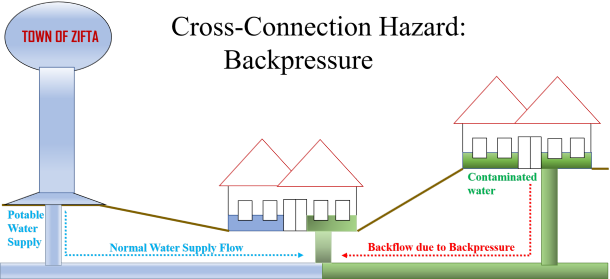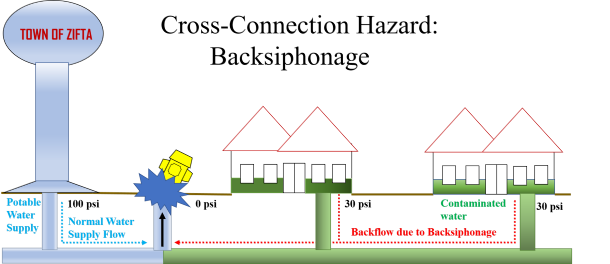Protecting Your Water: Backflow Prevention Program
Customer Self-Help
When a property requires backflow protection as mandated by California Administrative Code, Title 17, the customer will be responsible for: (1) having an approved backflow prevention assembly installed on their property and (2) ensuring this assembly undergoes routine testing on an annual basis by a certified tester. As a courtesy each year, LACWD will mail both a written notice as well as a backflow test form to each affected customer when it is time for the annual test of their backflow prevention assembly. If the test form is lost, please request a new test form by emailing backflow@dpw.lacounty.gov or alternatively, a blank test form may be downloaded using the following hyperlink: Backflow Prevention Assembly Field Test and Maintenance Report Form.
The customer is also responsible for contracting a certified tester, providing them with the test form, and ensuring that the completed test form is emailed to backflow@dpw.lacounty.gov before the specified due date. A list of certified testers can be found on the County of Los Angeles Public Health’s webpage:
http://www.publichealth.lacounty.gov/eh/safety/cross-connection-backflow-prevention-devices.htm.
It is recommended that the customer keeps a copy of the completed backflow test form for their own records.
A water shut-off notice will be issued to customers who fail to arrange having their backflow prevention assembly tested by a certified tester before the specified due date. If the customer is non-responsive within the allotted time, LACWD may terminate water service to the property until the assembly is tested and the completed form is submitted.
Cross-Connection Control & Backflow Prevention Program Background
A cross-connection is any connection between a safe drinking water system and any other untested water source, system, or equipment that may contain unsafe substances. LACWD’s public water systems are designed to keep water flowing in one direction—from LACWD’s water main to the customers’ connections. When an undesirable condition known as backflow occurs, water can flow in the opposite direction and may bring contaminants or pollutants into the public drinking water supply through a cross-connection.


Backflow is caused by a backsiphonage or a backpressure condition in the public water system. Backsiphonage may occur when the pressure in the public water system drops below atmospheric pressure and creates a vacuum that may pull unsafe substances into the public water supply. Backpressure may occur when the pressure from a private water system becomes greater than the pressure in the public water system. This difference in pressure may allow unsafe substances from the private water system to enter the public water system. Approved backflow prevention assemblies are designed to prevent backflow of contaminants or pollutants from entering the public water systems.
In order to protect our public water systems from potential contamination, LACWD has implemented a Cross-Connection Control and Backflow Prevention Program (Program) in accordance with the California Administrative Code, Title 17. The program consists the following elements:
- Maintain inventory of all the backflow prevention assemblies for LACWD’s water systems
- Ensure annual testing of all backflow prevention assemblies
- Complete plan reviews for new connections to LACWD’s water systems
- Train employees on cross-connection control and backflow prevention
For more information, please email at Backflow@dpw.lacounty.gov.
Facts and Questions
What is backflow?
Backflow is when water flows in the opposite direction in your pipes, potentially pulling dirty or contaminated water back into the clean drinking water supply.
Why is backflow a problem?
It can allow things like chemicals, bacteria, or other pollutants to enter the public water supply, making the water unsafe to drink.
How does backflow happen?
Backflow usually occurs when there’s a sudden change in water pressure. For example, if a fire hydrant is opened nearby or a water main break, water pressure can drop and cause water to be pulled backward.
What is a backflow prevention device?
It’s a mechanical device installed on certain plumbing systems that keeps water flowing in the right direction, so contaminants never enter the public water system.
Do I need a backflow prevention device?
Not every home or business needs one. They’re typically required for places with higher risk, such as irrigation systems, pools, fire sprinklers, medical facilities, restaurants, or businesses that use chemicals.
How often does my backflow device need to be tested?
State law requires backflow prevention devices to be tested once every year by a certified tester. This ensures the device is working properly.
Who can test my backflow device?
Only a state-certified backflow tester can perform the inspection.
What happens if I don’t test my backflow device?
If your device isn’t tested on time, we may issue a violation notice or even shut off service to protect the water supply.
How much does a backflow test cost?
The cost can vary by tester and location, but it’s usually between $75–$150 per device.
How long does a backflow test take?
Most tests take less than 30 minutes, depending on the size and type of device.
Can I test my own backflow device?
No. Only certified backflow testers with specialized equipment can perform the test.
Do I need to be home for the test?
Usually not, if the tester has access to the backflow device. Some devices are outside meters or irrigation controls.
What if my backflow device fails the test?
The tester will let you know what repairs are needed. In most cases, the device can be repaired and retested. If not, it may need to be replaced.
How will I know when my backflow test is due?
Your water provider will send you a notice each year. However, it is the customer’s responsibility to schedule the test and ensure results are submitted on time.
Where is my backflow device located?
It’s usually installed outdoors near your water meter, irrigation line, or fire sprinkler connection. If you’re not sure, a tester or your water provider can help you locate it.
How to request my test form?
Please email us at backflow@dpw.lacounty.gov and include the address where the backflow devices are located the associated customer or account number.
Resources
- Backflow Prevention Assembly Field Test and Maintenance Report Form
- Certified Backflow Prevention Assembly Testers
LACWD accepts test, repair, and installation of backflow prevention assemblies performed by a backflow tester certified by the County of Los Angeles Department of Public Health. A list of certified testers can be found on the County of Los Angeles Public Health’s webpage:
http://www.publichealth.lacounty.gov/eh/safety/cross-connection-backflow-prevention-devices.htm - Approved Backflow Prevention Assemblies
LACWD accepts backflow prevention assemblies approved by the USC Foundation for Cross-Connection Control and Hydraulic Research. Backflow prevention assemblies for domestic lines must also meet the “lead free” requirements per Health and Safety Code (HSC) section 116875. List of approved backflow prevention assemblies: http://fccchr.usc.edu/list.html - County of Los Angeles Department of Public Health
LACWD does not monitor on-site backflow prevention assemblies that protect the internal plumbing system within the property. LACWD does not administer backflow tester certification. For annual testing of on-site backflow prevention assemblies or backflow tester certification, please contact the County of Los Angeles Department of Public Health’s Cross Connection and Water Pollution Control Program at:
Webpage: http://www.publichealth.lacounty.gov/eh/EP/cross_con/cross_con_backflow.htm
Email: CCWPCP@ph.lacounty.gov
Phone: (626) 430-5290